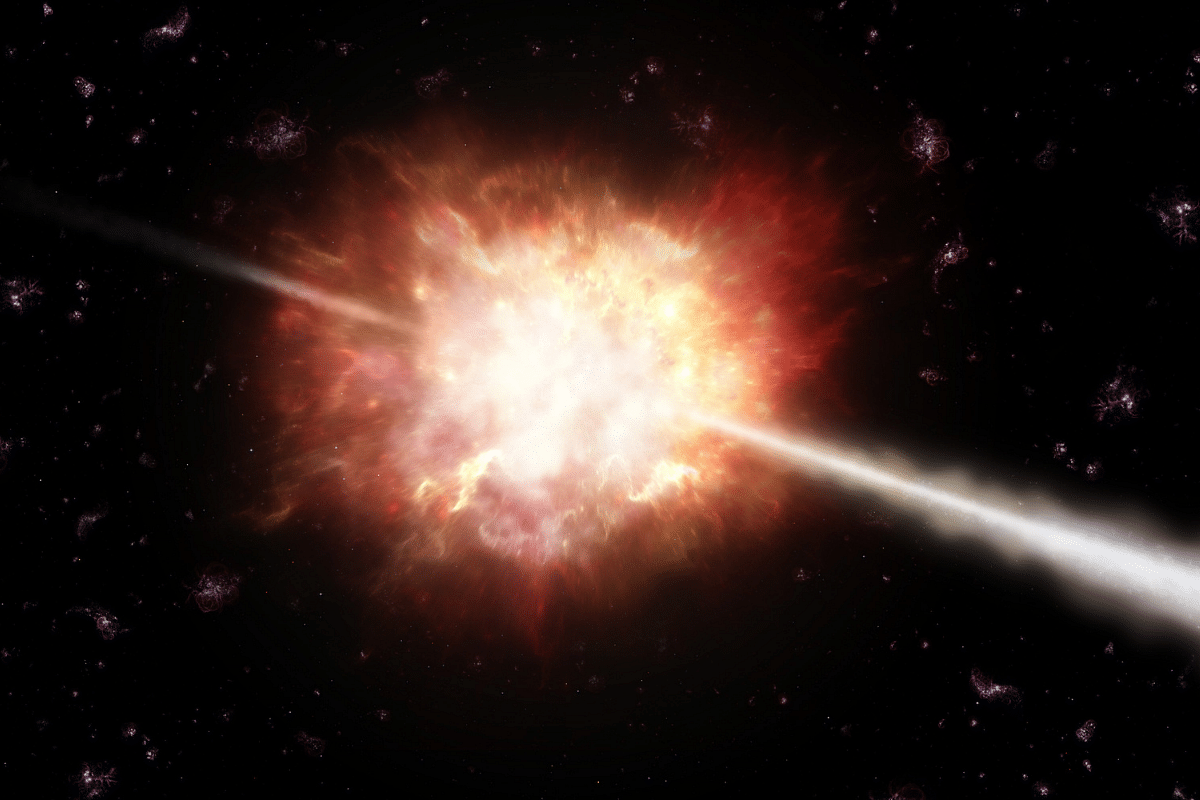Science
AstroSat Milestone: India’s Space Telescope Watches Black Hole Birth For The 500th Time And Going Strong
- In a "landmark achievement," India's AstroSat has witnessed the birth of black holes for the 500th time.

An artist’s impression of a gamma-ray burst (GRB). (Image: ESO/A. Roquette)
AstroSat, India’s first dedicated multi-wavelength space observatory, has crossed a special landmark — it watched the birth of black holes for the 500th time.
Black holes are among the most mysterious objects in the universe and have occupied the popular psyche for long. The oft-repeated enthusiastic description — "even light cannot escape it" — may have gotten old, but still speaks to the ability of black holes to tickle the human mind.
For AstroSat to have witnessed the birth of these not just light- but mind-bending cosmic objects for the 500th time is truly an accomplishment. (Full list here)
Professor Dipankar Bhattacharya of Ashoka University and the Inter-University Centre for Astronomy and Astrophysics (IUCAA) has called this a “landmark achievement.”
Among the five instruments on board AstroSat, the one doing black hole watching is called the Cadmium Zinc Telluride Imager (CZTI).
The CZTI has been at it — studying what are called “gamma-ray bursts” (GRBs) — since it got to work six and a half years ago, according to the news release by Pune-based IUCAA, which is one of the partners on the project and runs the Payload Operation Centre for AstroSat.
“The very first scientific result from AstroSat was the detection of GRB 151006A: just hours after the instrument was powered on after launch”, Professor Varun Bhalerao, who leads the GRB search effort, said in the IUCAA report.
Gamma-ray bursts are expressions of some of the most violent events occurring in the universe. Whether it’s the death of a star or a scenario where two neutron stars or a neutron star and a black hole merge, GRBs accompany the formation of a black hole.
Rather than from the explosion, the bursts come from two jets of plasma that shoot out at near the speed of light in opposite directions from the core of the dying star. If at least one of these jets is pointed towards Earth, a gamma-ray burst can be detected.
These bursts can outshine an entire galaxy. But since the Earth’s atmosphere blocks gamma rays, they have to be detected up high, either via balloons or space telescopes. (Ground-based telescopes have started to detect GRBs indirectly since 2019 with assistance from space-based counterparts.)
Here’s where AstroSat comes into play. It was shot up into a 650 km orbit, piggybacking on the polar satellite launch vehicle PSLV-C30, from Satish Dhawan Space Centre, Sriharikota, on 28 September 2015. It’s been going strong ever since. It completed five years of in-orbit operations in September 2020. Though it was given a five-year operational lifetime at the start, it is approaching seven years now and is expected to continue serving for many more years.
According to Indian Space Research Organisation (ISRO)’s annual report 2021-22, AstroSat is currently serving 1,530 users from 48 countries and data from the satellite has led to 86 refereed and over 500 non-refereed publications in 2021, with about 300 unique observations during this period.
The report lists three major discoveries or results from AstroSat during the 2021-22 period (page 72): the discoveries of three star-forming galaxies in the Bootes Void and of strong hard X-ray pulsations from Galactic Ultraluminous X-ray Pulsar Swift J0243.6+6124, alongside the confirmation of the symbiotic nature of a star Su Lyn with the Ultraviolet Imaging Telescope (UVIT) spectrum.
The CZTI and four other instruments on AstroSat enable the study of the universe in ultraviolet, optical, and X-ray light simultaneously.
“The science objectives of the CZTI,” as stated in the AstroSat Handbook, “include the measurement of curvature and reflection components in the spectra of Active Galactic Nuclei and X-ray binary systems, the study of Quasi-Periodic Oscillations at hard X-ray bands in accreting neutron star and black hole systems, cyclotron line spectroscopy of high mass X-ray binaries, the characterization of hard X-ray spectra of magnetars as well as the detection of gamma ray bursts and the study of their early light curves.”
Several Indian research institutes, such as the Tata Institute of Fundamental Research, Vikram Sarabhai Space Centre, and Physical Research Laboratory, contributed alongside the industry to the creation of the CZTI.
The CZTI, one among the four X-ray instruments on AstroSat, covers the energy band from 10 to 100 kilo-electron volt (keV) and has a large detection area of about 976 square centimetres.
The Indian Institute of Technology Bombay, Mumbai, leads the search and study of GRBs in close collaboration with IUCAA. Once the Laser Interferometer Gravitational-Wave Observatory (LIGO)-India gets underway, India’s GRB search-and-study effort will receive further impetus.
Also Read:
Introducing ElectionsHQ + 50 Ground Reports Project
The 2024 elections might seem easy to guess, but there are some important questions that shouldn't be missed.
Do freebies still sway voters? Do people prioritise infrastructure when voting? How will Punjab vote?
The answers to these questions provide great insights into where we, as a country, are headed in the years to come.
Swarajya is starting a project with an aim to do 50 solid ground stories and a smart commentary service on WhatsApp, a one-of-a-kind. We'd love your support during this election season.
Click below to contribute.
Latest